Advanced guide¶
On this section, we give an overview of the NUBOMEDIA architecture, with special emphasis on the part of computer vision. Let’s start with a simple explanation of what NUBOMEDIA is. Imagine a media communication using Skype. But instead of using Skype, this time we use web browsers, through a PC, table or mobile phone. Now, in the middle of this communication We can introduce different boxes or filters. This boxes or filters have a specific functionality. In particular, such funcionality is related to media capabilities such as encryption, transcoding, computer vision and augmented reality.
At this point, we can differentiate two parts the client part which runs in the browser and the cloud part running over OpenStack which has the logic of the application and is capable of creating the different filters (multimedia capabilities) in the cloud with the specific functionalities and establish the corresponding communications among the filters. Therefore we can distinguish three different modules:
- Client Application: which involves the native multimedia capabilities of the browser plus the specific client-side application logic.
- Application Server (AS): which runs on the cloud and contains the server-side application logic.
- Media Server (MS): which runs on the cloud and is responsible for receiving commands for creating specific filters.

The main technologies used for this architecture are: OpenStack, Kurento and different techniques that make it possible to develop the different features of the filters.
From now on, we will focus on the part of computer vision. The different computer vision filters are integrated in NUBOMEDIA through the Media Elements (ME). These media elements are created by the Media Server (MS). The media elements are monolithic and abstractions elements which send and receive media streams and data through different protocols. The goal of these elements is to carry out specific processing of the media stream or the data. Specifically, the VCA media elements are focused on applying VCA algorithms in order to extract valuable semantic information.
Now, we are going to see how to integrate these algorithms and how to process the video and data. The Media Elements offer the possibility to develop a specific algorithm through a GStreamer plugin. These plugins offer to the developers the video, frame by frame in a specific function. Therefore, the user can perform the processing of the frame in this function. With the aim to process every frame the developers can use different libraries. On this project a high percentage of the algorithms are going to be developed using the OpenCV library. On the other hand, an important percentage of the algorithms are going to be developed using other libraries. In the following figure we can see the different modules used to develop VCA filters contained on the media elements.

Finally, once the algorithm has been developed and installed, the developers can use the filter using the Java or JavaScript API.